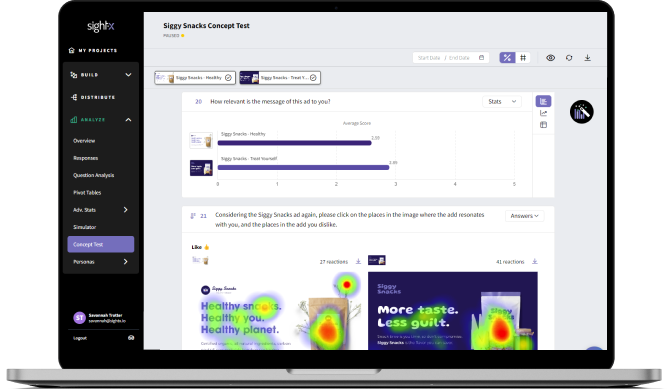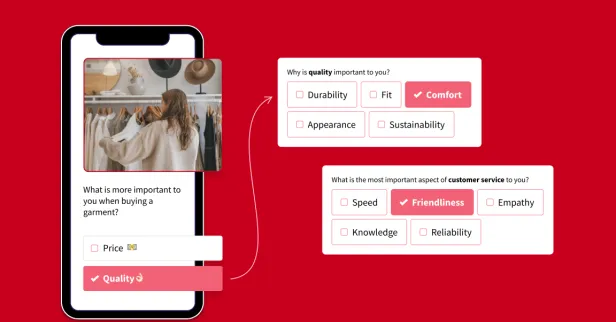It is no secret that creating compelling, high-impact creative assets is critical for capturing the attention of your audience and driving business success. Whether digital advertisements, packaging designs, logos, or user interfaces, every visual element you produce represents your brand and influences how customers perceive and interact with your products or services. Thorough creative testing is essential to ensure your creative efforts hit the mark.
Today, we'll explore creative testing, who should use it, various testing methods, tips for effective testing, and how generative AI can streamline the process.
What is Creative Testing and What Does it Encompass?
Creative testing involves evaluating different creative assets to determine their effectiveness in achieving desired outcomes. This evaluation process can include various elements such as advertisements, packaging designs, logos, user interfaces, and overall brand messaging. The primary objective is identifying which creative variations resonate best with your target audience, leading to enhanced engagement, higher conversion rates, and stronger brand loyalty.
Creative testing is not merely about aesthetics; it delves into your designs' emotional and psychological impacts. Businesses can make data-driven decisions to optimize their marketing strategies by understanding how creative elements affect their audience. This process helps fine-tune messages, visuals, and user experiences to ensure they align perfectly with audience expectations and preferences.
Creative Elements to Test
![]() Advertisements: Testing different ad formats, visuals, and messages to find the most effective combination.
Advertisements: Testing different ad formats, visuals, and messages to find the most effective combination.![]() Packaging Designs: Evaluating how packaging influences consumer perception and purchase decisions.
Packaging Designs: Evaluating how packaging influences consumer perception and purchase decisions.![]() Logos and Branding: Assessing different logo designs and brand elements to ensure they convey the right message.
Logos and Branding: Assessing different logo designs and brand elements to ensure they convey the right message.![]() User Interfaces: Testing UI designs for usability and user satisfaction to enhance digital interactions.
User Interfaces: Testing UI designs for usability and user satisfaction to enhance digital interactions.
Who Should Use Creative Testing?
Marketing & Advertising Professionals
Marketing and advertising professionals benefit immensely from creative testing. By testing various ad creatives, they can determine which messages and visuals resonate most with their target audience. This helps maximize click-through rates (CTR) and conversion rates, ensuring that marketing efforts are effective and efficient.
Design Teams
Design teams use creative testing to refine their visual elements, such as new logos, product packaging, or website layouts. Testing allows designers to understand which concepts appeal to their audience, leading to more effective and attractive designs that stand out in the marketplace.
UX/UI Teams
Creative testing is crucial for UX and UI teams to enhance the usability and aesthetic appeal of digital products. By testing different UI designs, these teams can ensure that applications and websites are intuitive, user-friendly, and engaging, thereby improving overall user satisfaction and retention.
Brand Teams
Brand teams leverage creative testing to ensure that branding elements like logos, taglines, and visual identities align with the company's values and resonate with the target market. This helps build a robust, consistent brand image that fosters consumer loyalty and trust.
Creative Testing Methods
Concept Testing
Concept testing involves presenting different creative concepts to your target audience to gather feedback on their preferences and perceptions. This method is particularly useful for evaluating new ideas before fully developing them. Concept testing helps identify and refine the most promising concepts based on audience feedback, ensuring that the final product or campaign is well-received.
Steps to Conducting a Concept Test:
1. Develop Multiple Concepts: Create different versions of your creative asset.
2. Survey Your Target Audience: Use surveys or focus groups to gather feedback on each concept.
3. Analyze Feedback: Identify common themes and preferences to determine the most effective concept.
4. Refine and Iterate: Make necessary adjustments to the preferred concept based on the feedback.

Heat Mapping
Heatmapping visually represents how users interact with a webpage or digital asset. It shows where users click, scroll, and spend the most time. This method helps understand user behavior and optimizes the layout and design of digital assets to enhance user engagement and conversion rates.
How to Use Heat Mapping:
1. Implement Heatmapping Tools: Use tools like Hotjar or Crazy Egg to track user interactions.
2. Analyze User Behavior: Review heatmaps to identify hotspots and low-engagement areas.
3. Optimize Layout: Adjust design elements to direct user attention to key areas.
4. Test and Iterate: Continuously test and refine the design using heatmap data.
A/B Testing
A/B testing, or split testing, involves comparing two versions of a creative asset to determine which one performs better. This method is commonly used for website elements, email campaigns, and digital ads. You can identify the most effective design, copy, and layout by testing different versions to achieve your marketing goals.
Steps to Conduct A/B Testing:
1. Create Variations: Develop two versions of the creative asset.
2. Split Your Audience: Randomly divide your audience into two groups.
3. Run the Test: Show each group a different version of the asset.
4. Measure Performance: Analyze key metrics such as CTR, conversion rates, and user engagement.
5. Select the Winner: Choose the version that performs better and implement it across your campaign.
Tips to Test Your Creative Assets Like a Pro
![]() Define Clear Objectives: Before starting any creative test, define your goal. Are you looking to increase engagement, improve conversion rates, or enhance brand perception? Clear objectives will guide your testing process and ensure you measure the right metrics.
Define Clear Objectives: Before starting any creative test, define your goal. Are you looking to increase engagement, improve conversion rates, or enhance brand perception? Clear objectives will guide your testing process and ensure you measure the right metrics.
![]() Know Your Audience: Understanding your target audience is crucial for effective creative testing. Use demographic and psychographic data to create detailed audience profiles and ensure your tests are tailored to their preferences and behaviors.
Know Your Audience: Understanding your target audience is crucial for effective creative testing. Use demographic and psychographic data to create detailed audience profiles and ensure your tests are tailored to their preferences and behaviors.
![]() Test One element at a Time: To accurately determine the impact of a specific element, test one variable at a time. This approach allows you to isolate the effects of each change and make data-driven decisions.
Test One element at a Time: To accurately determine the impact of a specific element, test one variable at a time. This approach allows you to isolate the effects of each change and make data-driven decisions.
![]() Use Control Groups: In A/B testing, always include a control group to compare against your test variations. This helps you understand the baseline performance and measure the true impact of your changes.
Use Control Groups: In A/B testing, always include a control group to compare against your test variations. This helps you understand the baseline performance and measure the true impact of your changes.
![]() Gather Qualitative and Quantitative Data: Combine quantitative metrics (such as click-through rates and conversion rates) with qualitative feedback (such as user comments and interviews) to comprehensively understand your creative assets' performance.
Gather Qualitative and Quantitative Data: Combine quantitative metrics (such as click-through rates and conversion rates) with qualitative feedback (such as user comments and interviews) to comprehensively understand your creative assets' performance.
![]() Iterate and Refine: Creative testing is an ongoing process. Use the insights gained from your tests to iterate and refine your creative assets continuously. This helps in staying relevant and effective in a dynamic market.
Iterate and Refine: Creative testing is an ongoing process. Use the insights gained from your tests to iterate and refine your creative assets continuously. This helps in staying relevant and effective in a dynamic market.
![]() Leverage Technology: Use advanced tools and software to automate parts of the testing process and analyze data more efficiently. This can save time and provide deeper insights.
Leverage Technology: Use advanced tools and software to automate parts of the testing process and analyze data more efficiently. This can save time and provide deeper insights.
![]() Document Learnings: Record all tests, results, and insights. This documentation can be valuable for future projects and help avoid repeating past mistakes.
Document Learnings: Record all tests, results, and insights. This documentation can be valuable for future projects and help avoid repeating past mistakes.
![]() Involve Stakeholders: Engage relevant stakeholders in the testing process to ensure buy-in and alignment with business objectives. This can lead to more comprehensive and accepted results.
Involve Stakeholders: Engage relevant stakeholders in the testing process to ensure buy-in and alignment with business objectives. This can lead to more comprehensive and accepted results.
![]() Stay Flexible: Be prepared to adapt your testing strategies as new data and insights emerge. Flexibility is key to effective creative testing.
Stay Flexible: Be prepared to adapt your testing strategies as new data and insights emerge. Flexibility is key to effective creative testing.
How to Use Generative AI to Streamline Creative Testing
Test Building
Generative AI can automate the creation of multiple creative variations, making it easier and faster to build tests. AI-driven tools can generate different ad copies, design layouts, and visual elements based on predefined criteria, allowing for more extensive and diverse testing.
Benefits:
![]() Efficiency: Quickly generate a wide range of creative options.
Efficiency: Quickly generate a wide range of creative options.![]() Consistency: Ensure all variations adhere to brand guidelines.
Consistency: Ensure all variations adhere to brand guidelines.![]() Scalability: Test multiple concepts simultaneously without extensive manual effort.
Scalability: Test multiple concepts simultaneously without extensive manual effort.
Analysis
AI-powered analytics tools can process large volumes of data quickly and accurately. They can identify patterns, trends, and insights that might be missed by human analysis. This enables marketers to make faster, more informed decisions based on real-time data.
Benefits:
![]() Speed: Rapidly analyze test results and gather insights.
Speed: Rapidly analyze test results and gather insights.![]() Accuracy: Minimize human error and bias in data interpretation.
Accuracy: Minimize human error and bias in data interpretation.![]() Depth: Uncover deeper insights through advanced algorithms and machine learning techniques.
Depth: Uncover deeper insights through advanced algorithms and machine learning techniques.
Iteration
Generative AI can also facilitate rapid iteration by suggesting modifications and improvements based on test results. AI algorithms can predict which changes will likely have the most significant impact, helping teams optimize their creative assets more efficiently.
Benefits:
![]() Proactive Adjustments: Receive real-time recommendations for improvements.
Proactive Adjustments: Receive real-time recommendations for improvements.![]() Continuous Optimization: Maintain a cycle of ongoing refinement based on the latest data.
Continuous Optimization: Maintain a cycle of ongoing refinement based on the latest data.![]() Enhanced Creativity: Explore new and innovative creative directions suggested by AI.
Enhanced Creativity: Explore new and innovative creative directions suggested by AI.
Creative Testing with SightX
Whether you are a marketing professional, a designer, or part of a brand team, creative testing should be an integral part of your strategy to ensure your creative assets achieve their full potential. Embracing these methods will not only enhance the effectiveness of your marketing efforts but also position your business for long-term success in a competitive marketplace.
At SightX, we infuse the power of generative AI with creative testing tools so you can:
![]() Create fully customized tests and experiments with a prompt, like: "I need to test the appeal of my ad creative."
Create fully customized tests and experiments with a prompt, like: "I need to test the appeal of my ad creative." ![]() Collect data from your target audience.
Collect data from your target audience.![]() Receive fully analyzed and summarized results in seconds, revealing key insights and personalized recommendations.
Receive fully analyzed and summarized results in seconds, revealing key insights and personalized recommendations.
Let us show you how simple it can be to collect creative insights
